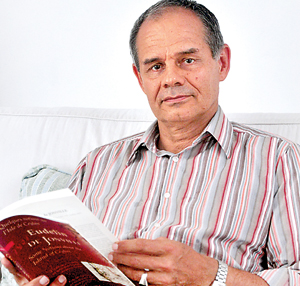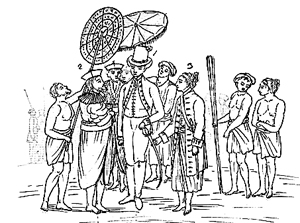Two Frenchmen, different times, one quest
By Smriti DanielSome Notions about the Island of Ceylon Late 18th Century, a French naturalist discovers Ceylon--- Marie-Helene Esteve, Philippe Fabry
After 10 years in Eudelin de Jonville’s company, Philippe Fabry quite likes the man. Even though 200 years separate these two Frenchmen living in Sri Lanka, Jonville and Philippe would have been natural companions. They are both knowledgeable men prone to curiosity; restless wanderers, meticulous observers, gifted with pen and paintbrush alike. Jonville would have been envious to hear of how much of Sri Lanka Philippe has already seen – as a foreigner arriving here in the last years of the 18th century his explorations were considerably more restricted.
However, the indefatigable Frenchman left behind a singular manuscript which Philippe has spent a decade translating – to create ‘Some Notions about the Island of Ceylon’ .Jonville had to travel, investigate, question, count, measure, observe, draw, paint and above all write the island into vivid life. Here, he tells us, is what Ceylonese wore, this is what they ate, this is how they worshipped, this is how they danced and sang. This was how they lived.

Philippe Fabry with his book on Eudelin de Jonville. Pic by Mangala Weerasekera
Philippe first found ‘Quelques notions sur l’Isle de Ceylan’ (the original title of Jonville’s unpublished manuscript) sitting in the British Library in London. The three green, leather bound volumes contained samples of Jonville’s extraordinary paintings and illustrations. Butterflies and deer; buds, leaves and flowers, as well as people and places were exactingly represented. These intricate, painstaking pieces were in many cases captioned with the names of the plant or animal not only in French and Latin, but in Sinhala (transcribed phonetically into French) as well. Philippe began to transcribe Jonville’s text using photocopies of the manuscript that had been loaded onto microfilm.
Though he initially planned only to transcribe Jonville’s memoir into modern French, Philippe soon became convinced that Sri Lankan readers would welcome an English translation as well. Jonville is much admired by scholars and naturalists on the island, and his name is often bandied about. Philippe says that many enthusiasts have let him know that they were eagerly anticipating the publication of Jonville’s memoirs in English. Expectations are high because while Jonville’s manuscript has previously been produced in parts or imperfectly replicated, this is the first faithful version of ‘Some Notions about the Island of Ceylon’.
Despite the interest in his work, the facts of Jonville’s life have long been debated. He was first thought to be 17 and then found to be 40 when he arrived in Sri Lanka. At one time eight different spellings of his name were used, confounding would-be biographers. It is considering this state of affairs that Philippe counts himself lucky to have recruited Marie-Hélène Estève to write a biography to accompany his translation.
Most of what we know of Jonville comes from the years 1798 to 1805 – the period of his stay in Ceylon. During this time Jonville would prove himself an industrious, capable worker. Having travelled here in the entourage of the first British Governor Frederick North, he was made Superintendent of the cinnamon plantations and then Surveyor General – Sri Lanka’s first – in which capacity he established the Survey Department. For the latter, he would hand in report after report, Marie-Hélène writes, adding that he often included illustrated maps and drawings with each piece, be it on the various sorts of rice cultivated in Ceylon, on how pearls from the fisheries were valued or on how elephants were hunted.
Though the diversity of the work must have pleased him, Jonville occasionally voiced his frustration on how these duties kept him from fulfilling what he considered Gov. North’s original mandate – that Jonville ‘inquire into and collect, whatever regards the natural philosophy, the natural history and the meteorology of the island. Likewise that I should inform myself concerning the customs, usages, history and even the languages of the country.’ However, it was while serving as an interpreter (he spoke Portuguese, Greek, Italian, French, Turkish, English and even knew some Sinhala) at the meetings between the first adigar of the kingdom, Pilima Talauve and General MacDowall, that Jonville enjoyed a ringside seat and an enviable insight into the unfolding power struggle. For the reader this is exciting stuff, and the first-hand account Jonville provides is really quite extraordinary in its detail.
As a member of the Embassy to Kandy for instance, he became well acquainted with the endless rounds of court etiquette. ‘Here begin the ceremonies which never end as long as the Embassy remained in the territory of His Kandyan Majesty,’ Jonville wrote. His description of the opening exchange between the two parties bears him out: consider simply the very first step, the arrival of the credential letter. Since it bore the signature of the King, it was treated with great deference.
It arrived accompanied by four men carrying a canopy of white linen ornamented with fringe under which walked a fifth man, bearing on his head a silver dish in which the letter lay, wrapped in four envelopes of muslin, and that again enclosed in a bag made of cloth of gold. 24 coryas and four sepoys formed an honour guard and behind them came the ambassador with his retinue. Jonville goes on to faithfully reproduce the stilted, laboured exchange that follows and more rounds of courtly bowing and scraping. Over the following days, the company is disturbed at 5 a.m. and then again at 6 p.m. as local musicians pay loud homage to the letter. (He seems to have taken a particular dislike to the local music, which he refers to as ‘the most horrible din.’) Unsurprisingly, our narrator very quickly tires of the hullaballoo surrounding it.

One of the many sketches that illustrate the book
Despite all the thrilling stories of deposing kings and beheading treacherous adigars that follow, Jonville remained rather disinterested in local politics. Marie-Hélène confirms that impression: ‘Actually he was not much interested in diplomatic games: they were for him a pretext to study customs, costumes, attitudes and manners, while travelling enabled him to enrich his collection of plants and rocks.’ Fortunately from his modern reader’s perspective, Jonville triumphed over whatever tedious administrative duties came his way.
Not only did he produce his exhaustive memoir, he created roughly 300 drawings of the Sri Lankan flora and fauna. By the time he left the island in 1805 along with North, he had also translated the Kovul Sandesaya into English and put together his own menagerie, with animals from all over the island in it.
The manuscript, which he hoped his brother would publish, never really saw the light of day, though it would be referred to time and again by scholars and naturalists. For Philippe, Jonville remains a marvel – a man so well read that he seemed to know something about everything, whether it was religion or zoology.
However, while Jonville can lapse occasionally into an annoying air of assumed superiority his saving grace is that he doesn’t let this get in the way of providing detailed descriptions of what was going on around him. “He is a scholar,” says Philippe, emphasising that Jonville’s attitude set him apart from the priests, businessmen and scholars who typically wrote of Ceylon and that as far as histories go, here is one Sri Lankans will delight in discovering.
‘Some Notions about the Island of Ceylon’ is priced at LKR 2,900 in Sri Lanka only and available in all bookshops or contact Perera Hussein Publishing House on ph-books@sltnet.lk, number: +94 11 485 89 72
comments powered by Disqus

















